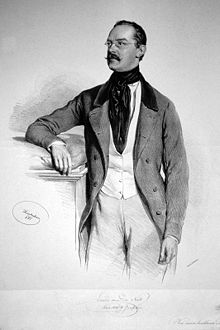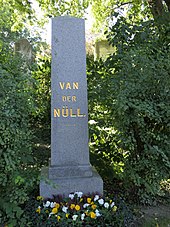Eduard van der Nüll

Eduard van der Nüll (baptized January 9, 1812 in Vienna ; † April 4, 1868 there ) was an Austrian architect who is considered one of the most important masters of historicism of the Ringstrasse era.
Live and act
After studying at the Polytechnic in Vienna and studying at academies (among others with Peter von Nobile , Paul Wilhelm Eduard Sprenger and Carl Roesner ), he went on extensive study trips through Western Europe with his friend August Sicard von Sicardsburg . In 1844 he became a professor at the Vienna Academy , and a new chair for perspective and ornamentation was created for him .
With von Sicardsburg he remained lifelong in a professional and artistic community, whereby von Sicardsburg was more responsible for practical-technical and van der Nüll for aesthetic-decorative questions. Their first joint work was the now demolished Carltheater in Vienna- Leopoldstadt in 1847 . They also built some parts of the arsenal in the 1850s, such as the command building. During this decade, Van der Nüll alone was in charge of the furnishing of the Altlerchenfeld parish church , an important transition from classicism to historicism.
Their most important joint work, however, is the court opera , which was built in the early Renaissance style from 1861 to 1869 as the first public building on Vienna's Ringstrasse . Opposite the Heinrichshof (destroyed in the Second World War and replaced by the Opernringhof in 1955 ), a huge private apartment building, however, it could not really develop its monumentality. The disappointment of the Viennese public that the long-awaited first monumental building on the new splendid boulevard was only half a success turned into a press campaign against the two architects, and Emperor Franz Joseph did not spare criticism either. After the street level in front of the opera was raised by one meter after the start of construction, the opera was referred to as a “sunken box” and - in analogy to the military disaster of 1866 - “ Königgrätz der Baukunst”.
Van der Nüll despaired of the criticism and hanged himself on April 4, 1868 (while his wife Marie was eight months pregnant). His colleague from Sicardsburg died almost 10 weeks later. It is said that the emperor reacted so shocked to van der Nüll's suicide that from then on he would only comment on all new art phenomena with the stereotypical phrase “It was very nice, I was very pleased” .
Eduard van der Nüll is buried in a grave of honor in the Vienna Central Cemetery (group 32 A, number 5). In 1875, in his native Vienna, Van-der-Nüll-Gasse in the 10th district of Favoriten was named after him.
Works and drafts
- Interior of Altlerchenfeld parish church , 1848–1861
- Pedestal for the monument to Archduke Karl on Heldenplatz , 1859
- Base for the monument to Prince Eugene on Heldenplatz , 1856
together with August Sicard von Sicardsburg
- Guardian Angel Fountain , 1843–1846
- Sophienbad , 1845
- Carltheater , 1846–1847
- Arsenal , 1849–1855
- Court Opera , 1861–1869
- Haas House , 1866–1868
- Palais Larisch-Mönnich , 1867–1868
- Industrial palace on the occasion of the Vienna World Exhibition in 1873
Arsenal object 1
Altlerchenfelder parish church , interior view
Altlerchenfelder parish church , interior view
Pedestal equestrian monument Archduke Karl on Vienna's Heldenplatz
The carpet store "Philipp Haas & Sons" at the end of the 19th century
Rotunda / Industrial Palace Vienna World Exhibition 1873
Known students
- Heinrich von Ferstel (1828-1883)
- Otto Wagner (1841-1918)
literature
- anonymous: necrology on Eduard van de Nüll; In: Deutsche Bauzeitung , Volume 2, No. 15, April 10, 1868, pp. 144 f.
- Constantin von Wurzbach : Nüll, Eduard van der . In: Biographisches Lexikon des Kaiserthums Oesterreich . 20th part. Imperial and Royal Court and State Printing Office, Vienna 1869, pp. 422–426 ( digitized version ).
- Albert Ilg: Nüll, Eduard van der . In: Allgemeine Deutsche Biographie (ADB). Volume 24, Duncker & Humblot, Leipzig 1887, p. 51 f.
- Otto Antonia Graf: Nüll, Eduard van der. In: New German Biography (NDB). Volume 19, Duncker & Humblot, Berlin 1999, ISBN 3-428-00200-8 , p. 369 f. ( Digitized version ).
Web links
- Architekturzentrum Wien - Eduard van der Nüll
- Entry on Eduard van der Nüll in the Austria Forum (in the AEIOU Austria Lexicon )
- planet-vienna.com - Eduard van der Nüll
- Vienna Central Cemetery | Graves of honor | Group 32 A | No. 5 - Eduard van der Nüll
Individual evidence
- ^ Biography , Centralblatt der Bauverwaltung , July 21, 1883, pp. 259 and 260; Retrieved December 19, 2012
| personal data | |
|---|---|
| SURNAME | Nüll, Eduard van der |
| BRIEF DESCRIPTION | Austrian architect |
| DATE OF BIRTH | baptized January 9, 1812 |
| PLACE OF BIRTH | Vienna |
| DATE OF DEATH | April 4, 1868 |
| Place of death | Vienna |











